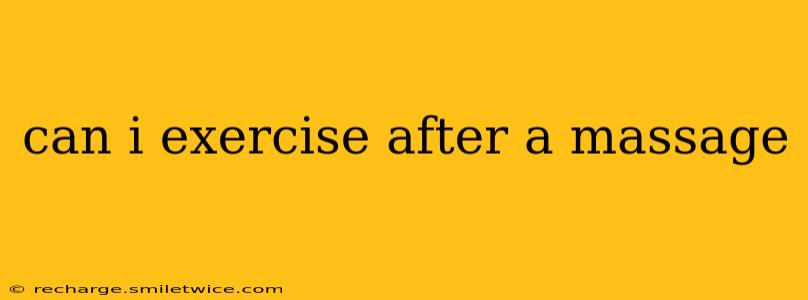Many people wonder if it's okay to exercise after a massage. The short answer is: it depends. While a massage can leave you feeling relaxed and rejuvenated, jumping straight into a strenuous workout might not be the best idea. This comprehensive guide will help you understand the factors to consider and how to safely incorporate exercise into your post-massage routine.
What Happens During a Massage?
Before we delve into exercise, let's understand what a massage does to your body. Massage therapy manipulates soft tissues, improving circulation and lymphatic drainage. This can lead to increased flexibility, reduced muscle soreness, and a general sense of well-being. However, this process also causes microscopic tissue damage, which is why proper recovery is crucial. The intensity of the massage and the type of massage (deep tissue, Swedish, sports massage, etc.) will also influence your post-massage recovery.
Should I Exercise After a Massage?
The ideal time to exercise after a massage depends on several factors:
- Intensity of the massage: A gentle Swedish massage will likely have less impact than a deep tissue massage focusing on tight, knotted muscles. Deep tissue massage, in particular, can cause significant muscle soreness and fatigue, making immediate exercise inadvisable.
- Type of exercise: Light activities like yoga or a gentle walk are generally fine after most massages. However, high-intensity interval training (HIIT), weightlifting, or endurance sports might be too much, especially after a deep tissue massage.
- Your personal experience: Listen to your body! If you feel energized and refreshed, a light workout might be beneficial. If you feel sore, tired, or stiff, it's best to rest.
- Goals of the massage: Were you getting a massage for relaxation, injury recovery, or performance enhancement? The answer to this question will significantly influence the advice regarding post-massage exercise.
What Type of Exercise is Best After a Massage?
If you choose to exercise after your massage, opt for gentle activities that promote relaxation and recovery rather than pushing your physical limits. These include:
- Light cardio: A leisurely walk, swimming at a slow pace, or cycling at a low resistance.
- Stretching and yoga: These activities increase flexibility and promote relaxation, further enhancing the benefits of the massage.
- Foam rolling: This self-massage technique can help alleviate any lingering muscle soreness.
How Long Should I Wait to Exercise After a Massage?
There's no single magic number, but generally, waiting at least 30 minutes to a few hours after a massage is recommended before engaging in any strenuous activity. This allows your body to recover from the massage and adjust to the increased blood flow and lymphatic drainage. For intense massages, waiting longer, potentially a full day, might be prudent.
What if I Feel Sore After My Massage?
Muscle soreness after a massage is common, especially with deep tissue work. If you experience soreness, prioritize rest and recovery. Gentle movement, such as light stretching or walking, may help, but avoid intense exercise until the soreness subsides. Consider using ice or heat to manage pain and inflammation.
Can I Exercise Before a Massage?
While it's generally okay to exercise before a massage, it's crucial to avoid overly strenuous workouts immediately beforehand. A light warm-up is usually fine, but intense exercise can make your muscles too fatigued for effective massage therapy.
Is it Better to Exercise Before or After a Massage?
The best time to exercise relative to your massage depends on your individual goals and the type of massage received. For relaxation, exercising afterward might negate the relaxing benefits, while for performance enhancement, exercising before a sports massage might be beneficial to prepare the muscles. Consult your massage therapist for personalized recommendations.
This guide provides general advice; always consult with your massage therapist or doctor if you have any concerns about exercise after a massage, especially if you have any underlying health conditions. Remember to listen to your body and prioritize its needs.
